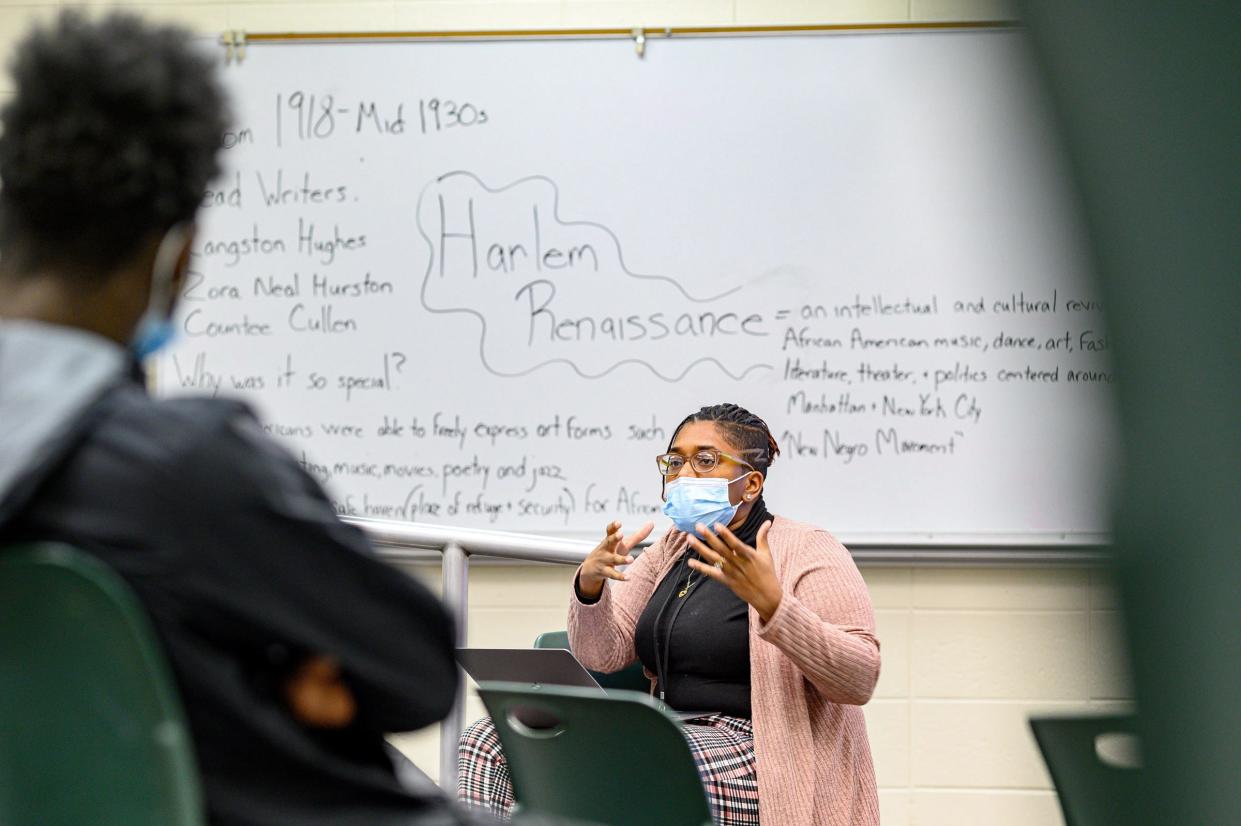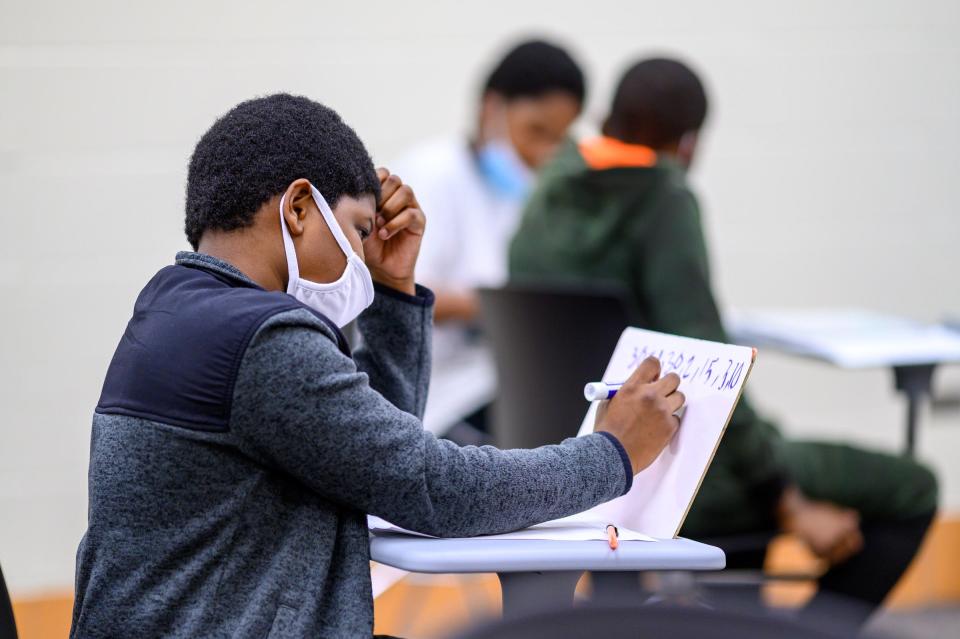What do this year's ILEARN scores mean for learning recovery in South Bend?

As students return for their third fall of the coronavirus pandemic, educators will be armed with another data point to help guide students through learning recovery.
The results of Indiana’s 2022 ILEARN test were shared publicly last month, showing that students have made slight academic gains, but have not entirely caught up to where they should be.
The ILEARN test is given in the spring to students in grades 3-8. Third- through eighth-graders are tested in English/language arts and math, while fourth- and sixth-graders take an additional science portion and fifth-graders take a social studies section of the test.
State officials, at the start of the pandemic, said they expect recovery to take anywhere from three to five years. This year’s state averages, showing less than half of Hoosier students passing English and math exams, may appear alarming. But educators say more context is needed to understand these results.
A one-two punch of major changes to the state’s exam followed by remote learning in 2020 have taken a toll on the results educators would typically expect to see. Aspects of the exam, however, can still be useful as teachers and school leaders identify where students need help the most.
ILEARN 2022:See how schools around Indiana performed
While some tend to fixate on school proficiency rates, educators say they often find greater value in analyzing how students performed on individual standards evaluated by the exam.
“Teachers can drill down to see where their students’ strengths are and where they need to work at,” said Caity Stockstell, director of teaching and learning for Mishawaka schools. “They can look at trends. Do we need to work more on writing or do we need to work more on literature, for example, in English/language arts?”
Mishawaka administrators say the district chooses not to treat the data, which is released in the summer after the school year ends, as “an autopsy,” but to find out where students tested well and where effective instructional styles can be replicated across the district.
“We want to make that data actionable,” Stockstell said. “We start using it for the next school year to … make sure we’re meeting the needs of our students at all different levels.”

How did students fare this year?
Hoosier students have taken the ILEARN exam only three times. Its first administration was in spring 2019 as the state adopted a more modern take on its former ISTEP exam.
The new test was written to align more closely to Indiana’s growing focus on college and career readiness. It was designed to be more rigorous than ISTEP and is computer-adaptive, meaning the difficulty of each question changes based on a student's previous responses.
In 2019, scores across the state averaged just about 48% proficiency in each English/language arts and math subjects. Then, the pandemic hit. Indiana officials waived the spring 2020 exam and reintroduced the test in 2021 as schools returned to in-person learning.
Results that spring were predictably low, with Indiana students testing at 40.5% proficient in English/language arts and 37% proficient in math. Those scores are now being used as a baseline to compare to this year’s results, which have shown some slight improvement. Statewide, 41.2% of students tested at or above proficiency in English/language arts and 39.4% tested at or above proficiency in math.
Districts like Penn-Harris-Madison saw most all schools test above state averages. Corporationwide, P-H-M saw 51% of its students test at or above proficiency in both the math and English/language arts exams compared to 47% in the same subjects last spring.
ILEARN 2022:See how the top Indiana schools performed
And, while this year’s scores show some improvement from last spring, state officials say, existing gaps remain among students of color and English language learners.
That need becomes readily apparent when looking at schools in the South Bend area ― some of which have historically performed below state averages. Nearly 10% of students in South Bend schools tested at or above proficiency in the English/language arts and math tests this year, compared to 7.5% last year.
Of South Bend’s schools, nearly all report significantly higher rates of diversity and economic disadvantage than Indiana’s averages. The district saw a nearly 30 percentage point gap between Black and white students’ performance in English and language arts this year, administrators said in a meeting this week.
Brandon White, the district’s assistant superintendent of academics,said the performance is reflective of a growing national trend that South Bend hopes to tackle through continued teacher training.
“We talk about equity a lot,” White said. “We are very intentional about how we choose curriculum to make sure that it’s culturally relevant, that we continue to work with our teachers around understanding implicit bias and understanding how to support all students.”

How are schools responding to low scores?
The South Bend corporation has worked over the last several school years to provide additional resources to schools its administrators have identified as needing more academic support. Through the creation of its Empowerment Zone in 2018 and “redesign” schools last year, district leaders have extended a certain level of autonomy to underperforming schoolsin an effort to allow local principals to pick curriculum, instructional styles and training for teachers that best meets individual students’ needs.
The Empowerment Zone ― created as an alternative to the potential state takeover or closure of Navarre Middle School ― saw some of the lowest ILEARN scores in South Bend.
Districtwide, fewer than 10% of students tested proficient in both English and math tests this year in 16 of the corporation’s 23 schools. Four of the Zone’s five schools, however, saw three or fewer students test at or above proficiency in both of the subjects. In the Zone’s Coquillard school, no students tested proficient in both math and language arts for the second year in a row.
New leadership:Empowerment Zone board names new chief
“That is definitely not what we want,” said Roxana Zapata, executive director of the instructional support team in South Bend Empowerment Zone schools. “We just know there’s a lot of work to be done. We want higher proficiency, for sure, but we know to get there looking at growth is going to tell us if we’re on track.”
Growth ― an indicator different from proficiency ― tells educators how students performed compared to other students with similar baseline scores and can help provide a clearer picture of student achievement independent of socioeconomic differences.
In a South Bend school board meeting Monday, RafiNolan-Abrahamian, the district's assistant superintendent for accountability and innovation, said recentgrowth scores across the district show students are stabilizing and recovering, but not at the rate educators had initially hoped to see. Nearly 50% of South Bend students were chronically absent last school year, Nolan-Abrahamian said, making expectations for substantial progress unrealistic.
Principals and teacher leadership teams across the South Bend district met over the summer to analyze ILEARN scores, as well as discipline and attendance data, and to develop school improvement plans.
Saturday Accelerator:How South Bend schools are hoping to catch students up
South Bend administrators are focusing this fall on improving student attendance, classroom instruction, and out-of-school learning opportunities to ensure growth happens in the coming year.
Zone leaders are hopeful that new instructional coaches introduced last year and a continued exposure to rigorous curriculum can help students who have fallen behind catch back up to their grade level.
“The kind of work that we’re trying to do is not going to show up right away in one year,” Zapata said. “But we can look at where things are in terms of some stronger, more solid growth and study that.”

Are ILEARN results useful?
Even before the pandemic, some educators were critical of the ILEARN test, which measures students’ knowledge at one point in time, once a year. Some say other tests, given multiple times throughout a year, bring more opportunity to assess students’ understanding of a subject in real-time and make course corrections before the school year ends.
The Empowerment Zone, for example, uses an exam called i-Ready that is given three times a school year and showed students moving 14 percentage points into their grade level from the fall 2021 to spring 2022.
The greater South Bend district plans to adopt i-Ready this year and recently approved a series of five-to-seven question “mini-assessments” developed, in part, by district teachers to help assess students each quarter in a low-stakes, rapid-return format.
Some educators, however, say exam data alone shouldn’t be relied upon as the only tool for improving academic outcomes. Linda Lucy, president of the NEA-South Bend teachers union, said children would be better served by investments in lower class sizes and more resources for direct classroom instruction.
“Standards get twisted so the only thing you’re teaching is teaching into a test,” Lucy said. “Put your energy into teaching and learning, not testing.”
IREAD-3 2022:Here's what you need to know about the results
Despite ILEARN’s complicated history, some educators say they’re not ready to ditch the test altogether.
“We have to embrace all data,” Zapata said. “We have to analyze it to see what it tells us and not over-interpret, but all data is good. It tells us stuff.”
Ultimately, educators stress that though the data points can help shape instruction, families who see their students didn’t meet proficiency this year shouldn’t view the results “with doom and gloom.”
“We don’t treat it that way,” Mishawaka Assistant Superintendent Sarah Hickle said. “It’s just a starting point. It helps us to better understand where the student is and where we have additional work to do.”
ILEARN student proficiency scores for 3-8 grade English/language arts and math
Indiana
2019: 37.1% proficient or 184,182 students proficient of 495,895 tested
2021: 28.6% proficient or 138,391 students proficient of 484,153 tested
2022: 30.2% proficient or 148,704 students proficient of 491,610 tested
South Bend Community School Corp.
2019: 15.3% proficient or 1,055 students proficient of 6,878 tested
2021: 7.5% proficient or 477 students proficient of 6,331 tested
2022: 9.8% proficient or 636 students proficient of 6,463 tested
Penn-Harris-Madison School Corp.
2019: 57.9% proficient or 2,756 students proficient of 4,761 tested
2021: 47% proficient or 2,313 students proficient of 4,919 tested
2022: 51% proficient or 2,556 students proficient of 5,007 tested
School City of Mishawaka
2019: 23.8% proficient or 543 students proficient of 2,282 tested
2021: 15.5% proficient or 347 students proficient of 2,236 tested
2022: 18.3% proficient or 415 student proficient of 2,264 tested
Email South Bend Tribune education reporter Carley Lanich at clanich@gannett.com. Follow her on Twitter: @carleylanich.
This article originally appeared on South Bend Tribune: ILEARN in South Bend schools: How are students recovering from pandemic?

